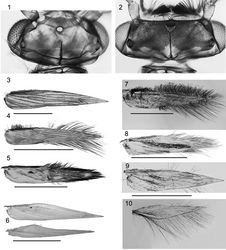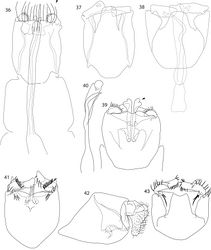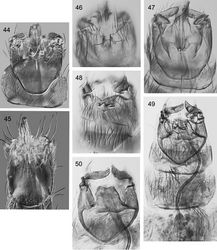Caledonotrichia minor
| Notice: | This page is derived from the original publication listed below, whose author(s) should always be credited. Further contributors may edit and improve the content of this page and, consequently, need to be credited as well (see page history). Any assessment of factual correctness requires a careful review of the original article as well as of subsequent contributions.
If you are uncertain whether your planned contribution is correct or not, we suggest that you use the associated discussion page instead of editing the page directly. This page should be cited as follows (rationale):
Citation formats to copy and paste
BibTeX: @article{Wells2013ZooKeys287, RIS/ Endnote: TY - JOUR Wikipedia/ Citizendium: <ref name="Wells2013ZooKeys287">{{Citation See also the citation download page at the journal. |
Ordo: Trichoptera
Familia: Hydroptilidae
Genus: Caledonotrichia
Name
Caledonotrichia minor Sykora – Wikispecies link – Pensoft Profile
- Caledonotrichia minor Sykora (1967: 585–595); Wells (1995: 230).
Revised diagnosis
Males of Caledonotrichia minor share with those of Caledonotrichia charadra, Caledonotrichia capensis sp. n. and Caledonotrichia ouinnica sp. n. the presence of androconia on the forewing only (Fig. 5), and are distinguished from these species by the size of the single patch of scales, which forms a small dark area proximally, though larger than the tiny black spot of Caledonotrichia ouinnica, whereas Caledonotrichia charadra and Caledonotrichia capensis sp. n. have large areas; in the male genitalia (Figs 38–40, 46–47), as in Caledonotrichia charadra and Caledonotrichia capensis, the ventral lobes of the gonopods in ventral view are triangular, but the sclerotised rods of the ventral processes are bilobed and broadly flared apically (arrow in Fig. 39), whereas the other two species have just a small subapical irregularity. The forewing of Caledonotrichia minor is not as slender as that of Caledonotrichia ouinnica, which tapers to an acute apex.
Revised description, male
Male head rounded as in Caledonotrichia capensis sp. n. (Fig. 1).
Antennae with 24–28 flagellomeres (n=5); flagellomeres elongate cylindrical. Maxillary palps with basal 2 segments short and rounded, rest cylindrical: segment 3 about 3× maximum width, segment 4 length about 2× width, and 5 elongate slender, length almost 6× width. Forewing (Fig. 5) length, 1.6–2.1 mm (n=5); small patch of slender scales medially at about one third length, some upright bristles on veins, costal margin hairs straight.
Material examined
Holotype, male: New Caledonia: River near Col d’Amieu (BPBM) (examined).
Other material examined:
New Caledonia: 1 male, Nékliai River, 5 km above Mission Station [near Poya], 10.viii.1965, F. Starmühlner (ROM); 1 pharate male pupa, larvae, Nerihouen River, St Ives, Reg. Ponérihouen, 27.viii. 1965, F. Starmühlner (ROM); 30 males, 7 females, Ouenghi River nr Boulouparis, 14.xii.1983, A. Wells (ANIC); 13 males, 8 females, same locality, 19.xii.1983, A. Wells (ANIC); 34 males, 7 females, Bopope, 18.xii.1983, A. Wells (ANIC); 28 males, ~10 km NW Hienghène, small stream, 25.xii.1998, A. Wells (ANIC); 2 males (on slides), Prov. Sud, Sarraméa, 220 m, forest stream, loc 10 21°37.883'S 165°51.958'E, Malaise trap, 18–21.xi.2001, Johanson, Pape & Viklund (NHRS).
Remarks
The mature larva illustrated by Wells (1995: 226, fig. 2)[1] is typically stactobiine, its case a round dome that is attached to the rock surface.
Taxon Treatment
- Wells, A; Johanson, K; Mary-Sasal, N; 2013: The New Caledonian genus Caledonotrichia Sykora (Trichoptera, Insecta) reviewed, with descriptions of 6 new species ZooKeys, 287: 59-89. doi
Other References
- ↑ Wells A (1995) New Caledonian Hydroptilidae (Trichoptera) with new records, descriptions of larvae and a new species. Aquatic Insects 17: 223-239. doi: 10.1080/01650429509361591
Images
|


